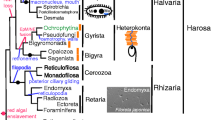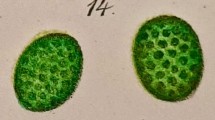Summary
Young spores of the mossTrematodon longicollis Mx. are highly polar. Immediately after meiotic cytokinesis an extensive system of microtubules associated with the single plastid develops under the entire distal face. Following exine initiation on the distal surface a microtubule system is elaborated at the site of aperture development on the proximal surface. Both plastid and nucleus move from distal to proximal pole and are attached to microtubules of the proximal system. Microtubules underlie the plasma membrane as it withdraws from the exine in the initiation of both the surrounding annulus and central aperture pore. The central pore enlarges to form a bowl-shaped concavity in which a fibrillar plug develops basipetally. The annulus expands into a fibrillar-filled protrusion surrounding the central pore. The mature aperture consists of a central pore plug covered by a thin roof of exine and separated from the surrounding annulus by exine lamellae. The aperture of the mature spore is obscured by development of the ornate exine and is not a prominent feature of the mature spore surface.
Similar content being viewed by others
References
Allen, C. E., 1916: Four-lobed spore mother cells inCatharinea. Amer. J. Bot.8, 456–460.
Bienfait, A., Waterkeyn, L., 1976: Sur la nature des parois sporocytaires chez les mousses et chez quelques ptéridophytes. Étude comparative. C. R. Acad. Sci. (Paris) Sér. D282, 2079–2081.
Brown, R. C., Lemmon, B. E., 1980: Ultrastructure of sporogenesis in a moss,Ditrichum pallidum. III. Spore wall formation. Amer. J. Bot.67, 918–934.
Chaloner, W. G., 1970: The evolution of microspore polarity. Geoscience and Man1, 47–57.
Eymé, J., Suire, C., 1969: Ultrastructure des cellules sporogènes des mousses: observations sur le plastidome et le chondriome. C. R. Acad. Sci. (Paris) Sér. D268, 290–293.
Fowke, L. C., Pickett-Heaps, J. D., 1978: Electron microscope study of vegetative cell division in two species ofMarchantia. Canad. J. Bot.56, 467–475.
Galatis, B., Mitrakos, K., 1980: The ultrastructural cytology of the differentiating guard cells ofVigna sinensis. Amer. J. Bot.67, 1243–1261.
Gantt, E., Arnott, H. J., 1965: Spore germination and development of the young gametophyte of the ostrich fern (Matteuccia struthiopteris). Amer. J. Bot.52, 82–94.
Genevès, L., 1971: Mise en place de polysaccharides membranaires dans le tissu sporogène de l'Hypnumrusciforme (Hypnacées) au cours de la phase de prolifération, et au début de la différenciation. C. R. Acad. Sci. (Paris) Sér. D273, 723–726.
Hepler, P. K., Palevitz, B. A., 1974: Microtubules and microfilaments. Ann. Rev. Plant Physiol.25, 309–362.
Kiermayer, O., 1972: Beeinflussung der postmitotischen Kernmigration vonMicrasterias denticulata Bréb. durch das Herbizid Trifluralin. Protoplasma75, 421–426.
Lambert, A.-M., 1974: Ultrastructure de l'appareil fusorial en méiose chez la mousseMnium hornum L. Bull. Soc. Bot. France121, 93–96.
— 1978: La méiose chez les Bryophytes: ultrastructure et dynamique du fuseau chez une mousse,Mnium hornum Hedw. Bryophytorum Bibliotheca13, 113–145.
McClymont, J. W., Larson, D. A., 1964: An electron-microscopic study of spore wall structure in the Musci. Amer. J. Bot.51, 195–200.
Neidhart, H. V., 1979: Comparative studies of sporogenesis in bryophytes. In: Bryophyte Systematics (Clarke, G. C. S., Duckett, J. G., eds.), pp. 251–280. New York-London: Academic Press.
Olesen, P., Mogensen, G. S., 1978: Ultrastructure, histochemistry and notes on germination stages of spores in selected mosses. Bryologist81, 494–516.
Pickett-Heaps, J. D., Fowke, L. C., 1970: Mitosis, cytokinesis, and cell elongation in the desmid,Closterium littorale. J. Phycol.6, 189–215.
Quatrano, R. S., 1978: Development of cell polarity. Ann. Rev. Plant Physiol.29, 487–510.
Reighard, J. A., 1967: Light and electron microscopic studies on spore germination and bud apical meristems inPolytrichum juniperinum Hedw. andP. ohioense Ren. and Card. Ph. D. dissertation, University of Illinois, Urbana.
Sapehin, A. A., 1915: Untersuchungen über Individualität der Plastide. Arch. Zellf.13, 319–398.
Schmiedel, G., Schnepf, E., 1979 a: Side branch formation and orientation in the caulonema of the moss,Funaria hygrometrica: normal development and fine structure. Protoplasma100, 367–389.
— — 1979 b: Side branch formation and orientation in the caulonema of the moss,Funaria hygrometrica: experiments with inhibitors and with centrifugation. Protoplasma101, 47–59.
Schnepf, E., 1973: Mikrotubulus-Anordnung und -Umordnung, Wandbildung und Zellmorphogenese in jungenSphagnum-Blättchen. Protoplasma78, 145–173.
— 1974: Microtubules and cell wall formation. Portugal. Acta Biol. Sér. A14, 451–462.
Schnepf, E., Stein, U., Deichgräber, G., 1978: Structure, function, and development of the peristome of the moss,Rhacopilum tomentosum, with special reference to the problem of microfibril orientation by microtubules. Protoplasma97, 221–240.
Weier, T. E., 1931: A study of the moss plastid after fixation by mitochondrial, osmium, and silver techniques. I. The plastid during sporogenesis inPolytrichum commune. Cellule40, 261–289.
Woodcock, C. L. F., 1971: The anchoring of nuclei by cytoplasmic microtubules inAcetabularia. J. Cell Sci.8, 611–621.
Author information
Authors and Affiliations
Rights and permissions
About this article
Cite this article
Brown, R.C., Lemmon, B.E. Aperture development in spores of the moss,Trematodon longicollis Mx.. Protoplasma 106, 273–287 (1981). https://doi.org/10.1007/BF01275558
Received:
Accepted:
Issue Date:
DOI: https://doi.org/10.1007/BF01275558




